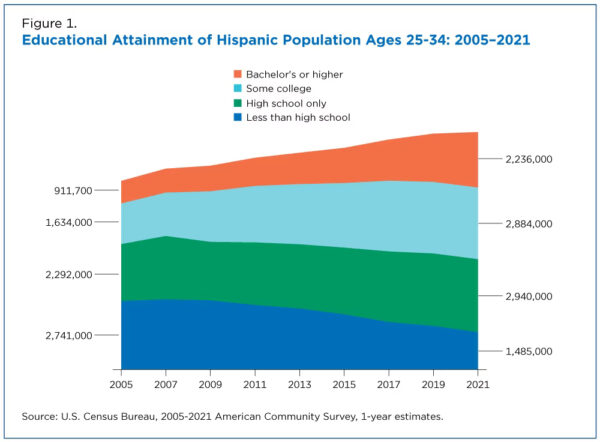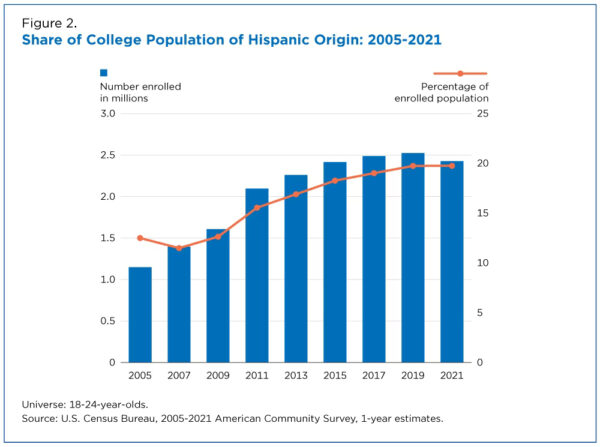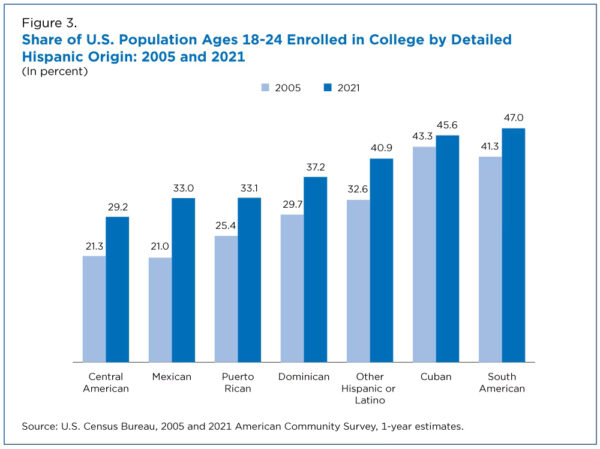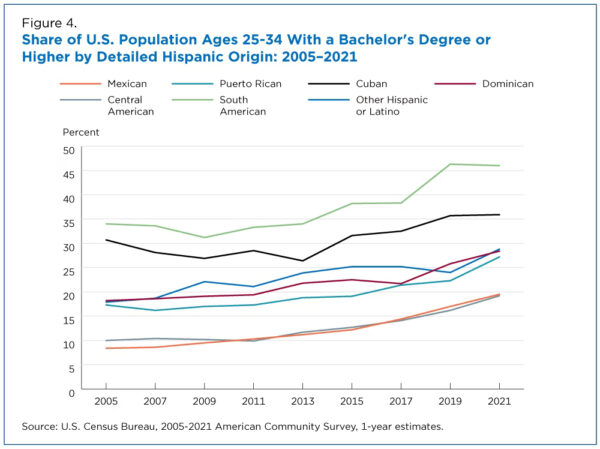Significant Educational Strides by Young Hispanic Population
May 11, 2023

The nation’s fast-growing Hispanic population made dramatic strides in educational attainment in recent decades — especially among younger age groups.
The number of people of Hispanic or Latino origin (referred to as the Hispanic population in this article) more than quadrupled from 14.6 million 1980 to 62.1 million 2021, and their share of the U.S. population jumped from 6.2% to 18.7%.
As the Hispanic population grew so did its educational attainment, especially high school graduation rates.
In 1996, 58.2% of the Hispanic population ages 25 to 29 graduated from high school; by 2021, the share increased to 88.5%, according to the U.S. Census Bureau’s Current Population Survey data tables.
The number of Hispanic people ages 18 to 24 enrolled in college increased to 2.4 million in 2021, up from 1.2 million in 2005.
Trends in educational attainment were particularly relevant for the nation’s Hispanic population given its low median age (30.5 in 2021).
For many Hispanic people in the United States, educational milestones are recent events. In 2021, the majority of Hispanic adults were between ages 25 and 34.
This young segment of the Hispanic population had the highest rate of college completion (bachelor’s degree or higher) as well as the lowest rate of not completing high school.
Educational Expansion for Young Hispanic People
We looked at 2005-2021 estimates of educational attainment among the young Hispanic population by four education categories: less than a high school degree; high school only; some college; and a bachelor’s degree or higher. A growing number of Hispanic people reached higher educational attainment over this time span (Figure 1).

In 2005, one-third of Hispanic people ages 25-34 had some college: 2.7 million had less than a high school education; 2.3 million only had a high school degree; 1.6 million had some college; and fewer than 1 million had a bachelor’s degree or higher.
By 2021, over half of young Hispanic people had some college. The number with less than a high school degree dropped 45.8% to 1.5 million. There were increases in all other categories: high school only (up 28.3% to 2.9 million); some college (up 76.5% to 2.9 million); and a bachelor’s degree or higher (up 145.2% to 2.2 million).
Increasing College Enrollment
From 2005 to 2021, an increasing number of Hispanic people enrolled in college and became a greater share of the total student population (Figure 2).

The number of Hispanic people ages 18 to 24 enrolled in college increased to 2.4 million in 2021, up from 1.2 million in 2005.
The share of all college students ages 18 to 24 who were Hispanic grew, too. The lowest share during the period (11.4%) was in 2006; by 2021 it had swelled to nearly 20%.
Educational Differences Between Hispanic Origin Groups
From 2005 to 2021, the percentage of 18-24-year-olds in all Hispanic origin groups enrolled in college or graduate school grew (Figure 3).

But there were different growth patterns. For example, Cuban and South American populations started with relatively high levels of college enrollment in 2005 and saw relatively small or non-statistically significant increases.
In contrast, other groups had lower levels of college enrollment in 2005 and larger gains over the period.
The Mexican population had the largest increase in college enrollment with a 12-percentage-point increase from 21% in 2005 to 33% in 2021. Puerto Rican, Dominican, Central American and other Hispanic or Latino populations also experienced enrollment increases of 7.5 percentage points or higher.
It became more common for all Hispanic origin groups to earn a bachelor’s degree from 2005 to 2021:
- South American (46%) and Cuban (35.9%) groups had higher levels of bachelor’s degree attainment than all other Hispanic origin groups in 2021 and for the entire 16-year period. The South American population had the biggest increase (12%) of any detailed Hispanic origin group.
- Mexican and Central American groups each saw increases of around 10 percentage points.
- Puerto Rican, Dominican, and other Hispanic or Latino populations had similar growth, starting between 15% and 20%, and increasing to between 27% and 28%.
 Figure 4.
Figure 4.
Within the larger educational trends of the Hispanic population, there were different starting points and patterns of growth for detailed Hispanic origin groups (Figures 3 and 4).
About Author
Erik L. Hernandez and Kevin McElrath are survey statisticians in the Census Bureau’s Social, Economic, and Housing Statistics Division.






























